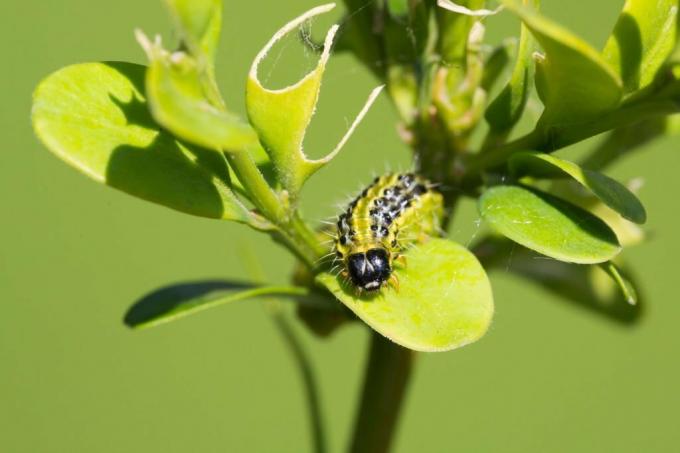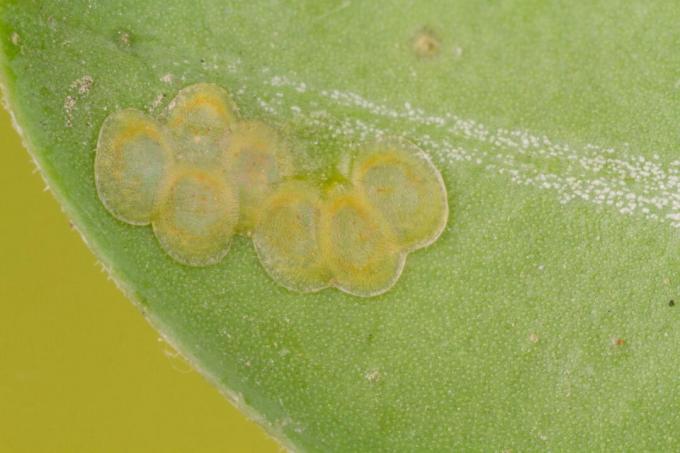Recognizing the moth flight of the box tree moth is the first step towards successful and early control. We introduce you to the moth.

The moth of box tree moth (Cydalima perspectalis) is in contrast to the annoying borer caterpillars pretty to look at. Attracted by the scent of the buddleia, it can also be observed on rare occasions during the day, although it prefers the dark hours of the night. We have put together everything you need to know about the little butterfly.
contents
- What does the moth of the box tree moth look like?
- When can you find the box tree moth moth?
- Lifestyle and life cycle of the box tree moth
The sighting of a box tree moth moth means that eggs will soon be laid and the hungry caterpillars will appear boxwood (Buxus) will come. So that you can recognize it with certainty, we explain and show what the box tree moth looks like, when you can find it and what the life cycle of this small butterfly is like.

What does the moth of the box tree moth look like?
The box tree moth is a small butterfly with a wingspan of just 4 to 4.5 centimetres. This corresponds roughly to the top two joints of your index finger. When the wings are spread, they slope backwards. Both the hindwings and the forewings end in a semicircle. The base of the wings is hairy, the compound eyes are black and the antennae are long and thin. Like all butterflies, the moth of the box tree moth also has a proboscis, which it keeps rolled up under its head when it is not using it to drink nectar from flowers. There is one thing about the coloring of the wings: the most common are white wings, the edges of which are lined with a brown band. This band is broken by a white spot at the front edge. Rarely, however, white-beige, completely brown, almost black and even dark violet shimmering color variations occur. The coloring of the abdomen is always adapted to the color of the wings and therefore also ranges from pure white to black.

When can you find the box tree moth moth?
The moth is mainly nocturnal. During the day it rests on the underside of the leaves of plants in the vicinity of the boxwood. If you want to know exactly when moths are in your own garden, you should use one Pheromone trap for box tree moths such as the Plantura borer trap make your own observations. Raising is most likely to be successful in June and August, in very warm years a moth can fall into the trap even in May and July. Knowing about the flight of moths is an important part of a successful flight Fighting the moth, because mating and oviposition take place during the flight of several days, so that the emergence of the first voracious larvae can be predicted quite precisely.
Once the moths have been discovered, control is usually necessary. It pays to act quickly. The bacterium is extremely effective in combating it Bacillus thuringiensis, also in ours Plantura Zünslerfrei XenTari® is included. The agent is applied when the caterpillars have hatched and then ensures an immediate feeding stop.
Lifestyle and life cycle of the box tree moth
Depending on the weather and temperature, there are two to three generations per year in Europe, overwintering in the caterpillar stage. From around mid-March to May, the larvae go through several stages of development, grow up to five centimeters in size and eat diligently on the box tree. At the beginning they were still in the protected interior of the bush, but now they are gradually penetrating the periphery.

After the last of the six caterpillar stages, pupation follows and then the moth hatches. This only lives for about eight to nine days, during which it mates and lays eggs. If it is the last generation of the year, the hatched caterpillars overwinter in the third or fourth larval stage, pupated in webs of caterpillar silk in the bush until they become active again in March at temperatures above 12 °C and the cycle starts again begins. In relatively cool Germany, there are usually two generations. The development cycle is summarized again in the following table.
| month | April | May | June | July | August | September |
|---|---|---|---|---|---|---|
| state of development | caterpillars (overwinters) | cocoons | butterflies, eggs | eggs, caterpillars | cocoons, butterflies | moths, eggs, caterpillars |
| generation | generation previous year | generation 1 | generation 2 |
Because the development of the moth from egg to butterfly can accelerate significantly in warm temperatures, these figures are only rough guide values.

How you die Box tree moth caterpillar can recognize and what their damage looks like, you can find out in this special article.
